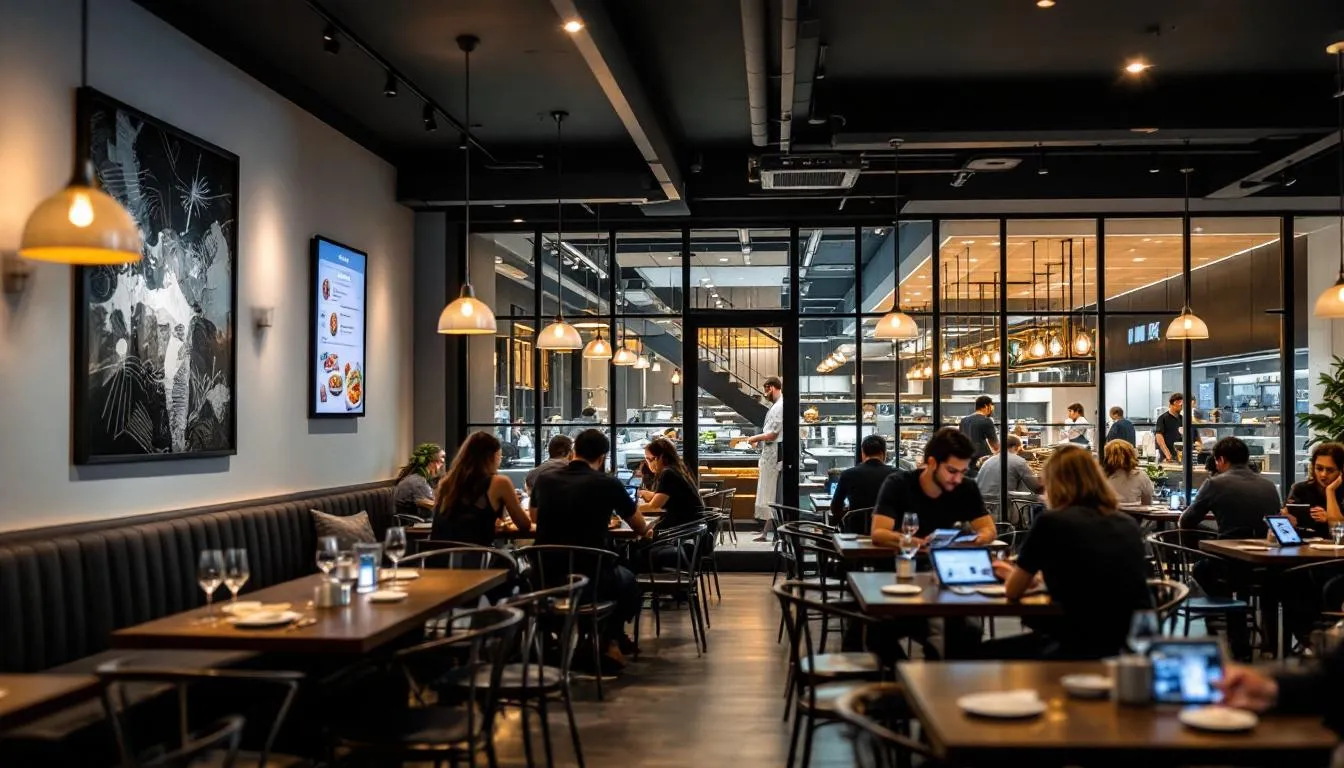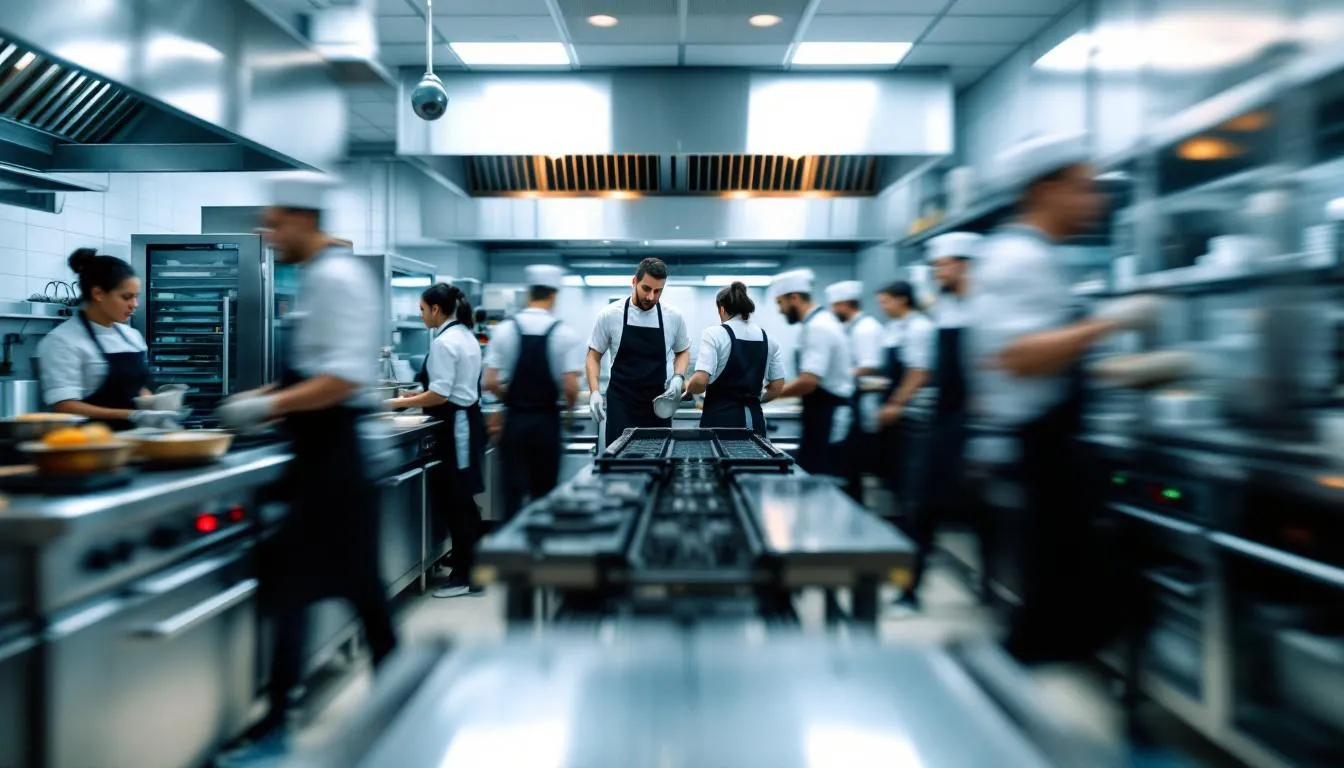Restaurant Market Statistics 2025: Growth & Trends
 Mika Takahashi
Mika Takahashi Mika Takahashi
Mika TakahashiThe restaurant industry is undergoing an exciting transformation in 2025. Despite facing economic challenges like inflation and labor shortages, the market is reaching new heights. For restaurant operators, staying on top of the latest market trends and data is more important than ever to navigate this evolving landscape successfully.
This in-depth look at restaurant market statistics 2025 highlights an industry generating a whopping $1.5 trillion in annual sales. It’s a testament to how restaurants are adapting—embracing new technologies, shifting consumer preferences, and weathering economic ups and downs. From workforce changes to how different segments are performing, these insights offer valuable guidance for anyone involved in the foodservice world aiming to stay competitive.
According to the National Restaurant Association, the U.S. restaurant and foodservice industry is expected to rake in $1.5 trillion in sales this year. This impressive figure covers everything from dine-in spots to the booming delivery and takeout services that have become staples for many customers.

This steady growth compared to previous years shows just how resilient the industry has been since recovering from the pandemic’s impact. It’s not just about more customers; smart investments in digital tools and innovative service models have helped restaurants improve efficiency across the board.
Market Share Breakdown by Restaurant Segments:
| Restaurant Segment | Market Share | Growth Rate | Key Characteristics |
|---|---|---|---|
| Quick Service Restaurants | 47% | Moderate growth | High volume, low margins |
| Fast Casual | 23% | Strong performance | Premium positioning, digital focus |
| Casual Dining | 18% | Steady growth | Full service, family-oriented |
| Fine Dining | 8% | Challenged performance | High-end experience, margin pressure |
| Coffee/Specialty | 4% | Niche growth | Convenience-focused, loyalty-driven |
Looking at the regional scene, New England and the Midwest are leading the pack in industry growth, while California and Texas are growing more slowly. These differences come down to local economic factors, regulations, and consumer habits that shape restaurant sales in each area.
Economic ups and downs continue to cast a shadow over the market size projections for the year ahead. Inflation is squeezing both costs and consumer spending, forcing restaurants to carefully balance value with profitability. Still, there’s a sense of cautious optimism that revenue growth will continue through 2025.
The restaurant workforce is expected to grow to 15.9 million employees this year, adding around 200,000 new jobsdespite ongoing staffing headaches. This growth underscores the industry’s importance as a major employer even amid challenges.
Replacing managers is expensive, with turnover costs topping $10,000 per position—and that’s not even counting general managers, who cost even more to replace. These figures highlight why creating a positive workplace culture and offering competitive pay are crucial for keeping good people around.
Key Employment Statistics for 2025:
With minimum wages rising in many areas, restaurants are getting creative with benefits, flexible schedules, and career development opportunities to attract and keep staff. The toughest hiring challenges are hitting quick service and casual dining spots hardest, prompting operators to boost recruitment efforts through employee referrals, better onboarding, and partnerships with culinary schools.
Wages also vary widely by region, with coastal cities generally offering higher pay than inland areas. This reflects differences in living costs and competition for workers across the country.
In May 2025, chain restaurants saw a modest 1.4% same-store sales growth, up from 1.1% in April. However, customer visits were down by 1.0%, meaning restaurants made more money mainly because people were spending more per visit, not because more people were coming in.
Quick service restaurants continue to lead the pack with strong profit margins and steady performance. Their streamlined menus and efficient service appeal to customers looking for convenience and value without sacrificing quality.

Segment Performance Analysis:
Fast Casual Restaurants are still riding high after a stellar 9.3% growth in late 2024, though growth has cooled to 0.9% in early 2025. They strike a great balance by offering higher-quality food with efficient service, ticking the boxes for consumers who want both value and a good dining experience.
Casual Dining remains steady, especially in family-friendly markets where sit-down meals are still popular. These full service restaurants are adapting well by boosting their takeout and delivery options.
Fine Dining Restaurants are feeling the pinch as economic uncertainty causes diners to cut back on luxury outings. Rising costs and tighter budgets are squeezing margins in this high-end segment.
Family Dining is getting hit hardest by inflation, with consumers cutting back on eating out. These restaurants need to carefully manage prices while meeting expectations for affordable, family-friendly meals.
These different performances reflect how consumer priorities shift during economic ups and downs. Operators are adjusting their strategies to meet changing tastes while keeping an eye on profitability in a competitive market.
Tipping habits have changed noticeably in 2025. Average tips dropped from 15.17% in Q1 to 14.99% in Q2, mirroring a dip in consumer confidence and a more cautious approach to spending. Since tips make up nearly 23% of many restaurant workers’ income, this trend has a real impact on employee earnings.
Tipping Trends by Restaurant Type:
| Restaurant Category | Q1 2025 Tips | Q2 2025 Tips | Change |
|---|---|---|---|
| Bars | 17.36% | 16.96% | -0.40% |
| Casual Dining | 15.84% | 15.67% | -0.17% |
| Fine Dining | 16.12% | 15.89% | -0.23% |
| Fast Casual | 14.58% | 14.32% | -0.26% |
| Coffee/Quick Service | 14.71% | 14.24% | -0.47% |
Economic uncertainty has diners hunting for more bang for their buck. Promotions, loyalty perks, and hearty menu options at fair prices are gaining traction. This value-driven mindset benefits restaurants that clearly communicate their worth through marketing and menus.
Geographically, California and Texas trail behind national spending averages, while New England and the Midwest are leading. These differences reflect local economies, employment, and confidence levels that influence how often and how much people dine out.
Younger diners, especially Generation Z, are shaping trends with a preference for customizable menus, sustainable ingredients, and tech-savvy ordering. They’re willing to pay more for restaurants that align with their values on environment and social issues.
Technology is becoming a must-have in restaurants, with 78% of owners saying online ordering drives most of their sales. This highlights how critical digital tools are for meeting customer convenience expectations today.
Owning first-party online ordering systems pays off—these generate 64% higher profit margins than third-party delivery apps. That’s why many restaurants are investing in their own platforms to build direct customer relationships instead of relying solely on external services.

Key Technology Adoption Metrics:
QR codes and contactless payments have gone from nice-to-have to expected basics, cutting costs and boosting convenience. POS systems help restaurants track inventory, sales, and customer data in real time, making management smarter and smoother.
Meanwhile, mobile ordering and delivery platforms continue to grow, though commissions eat into margins. Many restaurants find success with hybrid strategies that combine third-party exposure with incentives for direct orders to balance reach and profitability.
Quick service restaurants lead the way in adopting automation—kitchen tech, digital kiosks, and inventory systems—that help control labor costs while keeping food quality and speed consistent.
Oat milk is flying off the shelves, making up 33% of coffee orders in 2024 and jumping to nearly 50% in coastal stateswhere health-conscious trends take hold early. This shift is part of a larger move toward plant-based and sustainable eating.
Plant-based options are growing fast across all segments, especially casual and fast casual dining. These menu items appeal to eco-aware consumers and often carry better margins than traditional proteins.
Popular Menu Innovation Trends:
Seasonal changes and local sourcing keep menus fresh and support regional suppliers, helping restaurants stand out while appealing to customers who care about quality and community.
Sustainability efforts extend beyond plant-based dishes to responsibly sourced seafood, grass-fed meats, and organic produce. These premium ingredients cost more but let restaurants charge higher prices to customers who value ethics and quality.
Regional tastes also influence menu choices, with successful restaurants tailoring offerings to local preferences to build loyalty and word-of-mouth buzz.
Waste reduction is gaining ground too, as restaurants adopt portion control, better inventory management, and food donation programs—saving money and appealing to eco-conscious diners.
Profit margins vary widely between segments. Quick service restaurants typically enjoy the highest margins thanks to efficient operations, while fine dining faces tighter margins due to higher labor and ingredient costs.
Third-party delivery services take a big bite out of profits, often charging commissions between 15-30%. This pushes restaurants to find ways to encourage direct ordering while still offering delivery for convenience.
Profitability Metrics by Segment:
| Restaurant Type | Average Profit Margin | Revenue per Sq Ft | Break-even Timeline |
|---|---|---|---|
| Quick Service | 8-12% | $650-800 | 12-18 months |
| Fast Casual | 6-10% | $550-700 | 18-24 months |
| Casual Dining | 4-8% | $400-550 | 24-36 months |
| Fine Dining | 3-6% | $300-450 | 36-48 months |
| Coffee/Specialty | 10-15% | $700-900 | 8-15 months |
Smart cost management in 2025 includes menu engineering to highlight high-margin items, negotiating with suppliers, and investing in labor-saving tech. The best restaurants strike a balance between controlling costs and keeping customers happy.
Revenue per square foot varies by restaurant type and location, with urban spots usually pulling in more thanks to higher traffic and menu prices. These numbers help operators decide when and where to expand or renovate.
Break-even times for new restaurants reflect the big upfront investments needed. Quick service and specialty coffee shops tend to reach profitability faster because they’re simpler to run and serve more customers.
Investment is shifting toward tech, automation, and customer experience upgrades that build long-term profitability rather than quick cost cuts. These moves set restaurants up for sustainable growth in a competitive market.
Looking ahead, experts expect sales and traffic growth to slow down in the second half of 2025, as economic challenges continue to affect how much consumers spend on dining out. Inflation, job market stability, and overall confidence will all play a role in shaping the industry’s path.
Interest rates, unemployment, and consumer sentiment will be key factors to watch. Restaurants need to stay flexible with pricing and operations to stay profitable amid these shifting conditions.
Key Future Projections:
To weather market ups and downs, restaurants are focusing on menu tweaks, operational efficiency, and loyalty programs. Building strong customer relationships while staying agile will be crucial.
Investment in tech infrastructure—like kitchen automation, ordering systems, and data analytics—is expected to keep growing. These tools help restaurants run smoother and deliver better experiences while reducing labor needs.
Looking further out to 2026, growth remains cautiously optimistic. The industry’s resilience and adaptability mean there’s plenty of potential for those who can navigate today’s challenges and seize future opportunities.
Opportunities lie in expanding off-premises dining, innovating menus to match evolving tastes, and leveraging technology to boost efficiency. Restaurants investing in these areas while keeping customer satisfaction front and center will be best positioned for success.
The restaurant market statistics for 2025 paint a picture of an industry that’s overcoming hurdles while continuing to grow. The projected $1.5 trillion in sales speaks to strong consumer demand and the sector’s fundamental strength.
Operators who use these insights to guide strategy, technology upgrades, and customer experience improvements will thrive in this dynamic environment. Success means balancing efficiency with satisfaction and staying flexible as market conditions and consumer expectations evolve.
As the industry moves forward, keeping up with these trends and data will be key to making smart decisions that drive sustainable growth and profitability in an ever-competitive marketplace.